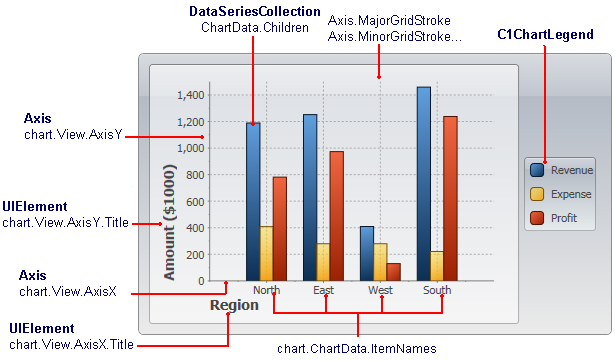
C1Chart Concepts and Main Properties
In order to create and format charts using the C1Chart control, it is useful to understand how the main properties map into chart elements. The diagram below illustrates this:

The steps involved in creating a typical chart are:
1. Choose the chart
type (ChartType
property)
C1Chart supports about 30 chart types, including Bar,
Column, Line, Area, Pie, Radial, Polar, Candle, and several others. The best
chart type depends largely on the nature of the data, and will be discussed
later.
2. Set up the axes (AxisX
and chart.View.AxisY properties)
Setting up the axes typically
involves specifying the axis title, major and minor intervals for the tick
marks, content and format for the labels to show next to the tick marks.
3. Add one or more data
series (chart.Data.Children collection)
This step involves creating
and populating one DataSeries object for each series on the chart, then
adding the object to the chart.Data.Children collection. If your data
contains only one numeric value per point (Y coordinate), use regular
DataSeries objects. If the data contains two numeric values per point (X
and Y coordinates), then use XYDataSeries objects instead.
4. Adjust the chart’s
appearance using the Theme and Palette properties.
The
Theme property allows you to select one of over 10 built-in sets of
properties that control the appearance of the overall chart. The Palette
property allows you to select one of over 20 built-in color palettes used to
specify colors for the data series. Together, these two properties provide about
200 options to create professionally-looking charts with little effort.